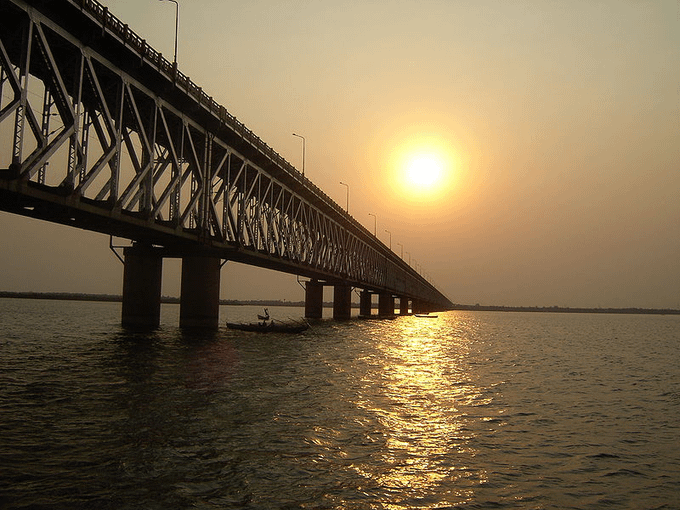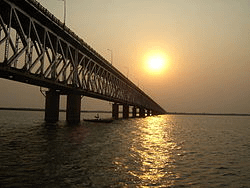Bridges On the Godavari
If you had travelled on the Chennai-Howrah route by train, you would have gone over one of these bridges on the Godavari river near Rajahmundry at sometime or other.
Basically the Godavari river, after traversing through Maharashtra, Telangana, reaches it's widest point at Rajahmundry spanning around 3 km, split into two channels, one at Rajahmundry , another at Kovvur , with an island in between. After this it breaks up into multiple tributaries forming the fertile delta region of Konaseema.
The oldest bridge is the Havelock bridge, so named after Sir Arthur Havelock, then Governor of Madras. The construction commenced on Nov 11, 1897 and the bridge was open to traffic on August 30,1900. Frederick Walton was the Chief Engineer for the bridge, who had also built the Dufferin bridge near Varanasi over the Ganga, now called the Malviya bridge, as well as the railway bridges at Wainganga, Bareilly, Moradabad and Kosi Rampur.
The Old Godavari bridge was constructed with stone masonry and steel girders, with 56 spans each measuring 45.7 m and is 3,480 m long. The girders were fabricated by the Butterley-Ripley company. The bridge was finally decomissioned in 1997, a good 100 years after it began.
Right now the Havelock Bridge is mainly used for water pipelines. There was a proposal to make this a national monument, but later changed to convert it into a tourist spot, for people to walk over. However this has not really taken off to date.
The rail cum road bridge connecting Rajahmundry and Kovvur is a truss bridge structure, and India's 3rd longest road-rail bridge after the Bogibeel bridge in Assam over the Brahmaputra, and the Digha-Sonpur bridge over the Ganga in Bihar.
This bridge is 4.1 km long consisting of 27 spans of 91.5m, and 7 spans of 45.72 m in a 6 degree curve at the Rajahmundry end, quite similiar to the Grafton Bridge in New South Wales. This curve would have been a familiar sight if you travelled here often.
The road-rail bridge over the Godavari was during the 3rd 5 year plan, when the Chennai-Howrah track was proposed to be doubled. The plan was sanctioned in 1964, but there was a demand from the residents for a road link also between Rajahmundry and Kovvur.
It was then that the Andhra Pradesh Govt, came up with the proposal to add a road deck over the railway bridge, and construction began in the early 70s. The bridge was finally inaugurated by then President Fakhruddin Ali Ahmed in 1974. Braithwaite, Burn & Jessop Construction Company was the one which built this road-cum-rail bridge. The iconic bridge remains a symbol of Rajahmundry to date.
The Godavari Arch bridge, basically a bowstring-girder one is one of the longest prestressed concrete arch bridges. Here the bridge spans 2 different channels, the Rajahmundry one is quite deep with a depth of around 66ft, while the Kovvur one is shallower, with depth of 23 ft.
It was built as a replacement for the Havelock bridge which was nearing it's end. The Hindustan Construction Company won the tender, and proposed the bowstring-girder type concrete arch with a span of 303 ft, and a prestressed concrete box girder to be the tie.
The Arch bridge was designed by Bureau BBR, a Swiss firm that specializes in bridge construction, known for their stay cable technology, while renowned German engineer Fritz Leonhardt did the testing for it.
The box girders, twin arches and struts are all made of prestressed concrete. The arches have a constant width of 2 ft 7 in and depth varying from 5 ft 7 in at the springing to 3 ft 7 in at the crown.
This bridge has 28 identical spans of twin arches shaped like a parabola, spaced at 18 ft, each covering 318 ft from center of one pier to another. Each girder is around 313 ft long, while the bridge has 28 piers supported it.
This arch bridge has been designed to run trains at a speed of 260 km per hour, and withstand wind speeds of around 320 km per hour, which is important, considering the Godavari delta is prone to cyclone storms.
The arches were designed to share 80% of the load, reducing the flexural, sheer stresses on the girder. Each span of the bridge has 24 hangers, while the box girders that comprise the deck are made of M42 grade concrete.
Construction on the arch bridge began in 1991, and was completed in 1997, it became fully operational by 2003. A truly awesome feat of engineering.
The 3 bridges over the Godavari river, are truly a great feat of engineering, that have stood the test of time and been a part of our memories travelling on the Chennai-Howrah route.














